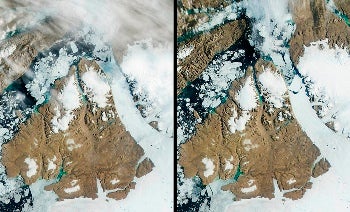
La página que intenta visitar sólo está disponible en inglés. ¡Disculpa!
The page you are about to visit is currently only available in English. Sorry!


Before and after: Satellite images of the Petermann glacier from July 16, 2012 (left) and July 17, 2012 (right). Photo credit: NASA Goddard Photo and Video / CC BY 2.0
A massive iceberg twice the size of Manhattan broke from Greenland’s Petermann Glacier last Tuesday. But this isn’t the first time the Petermann has been in the spotlight: A similar event occurred two years ago, when a chuck of ice four times as large as Manhattan broke, or calved, from the glacier in August of 2010.
NASA’s polar-orbiting Aqua satellite took before-and-after photographs of the calving as it passed over Greenland. The 46 square mile iceberg, known as an ice island, is clearly visible near the glacier’s edge. The break also created hundreds of smaller icebergs that are drifting away from the glacier.
The Petermann Glacier is located in remote northwestern Greenland and flows sinuously into the Arctic Ocean. Calving events occur on all glaciers, and this event wasn’t a complete surprise. Scientists were aware of a long crack in the glacier that was present for several years, reports the Associated Press.
What sets the recent Petermann calving apart is the time frame: two major events in two years. "This is not part of natural variations anymore," said NASA glaciologist Eric Rignot, to the AP.
Calving is the most dramatic way that glaciers deteriorate, but melting actually accounts for the most ice lost. Flowing from the Greenland ice sheet to the south, part of the glacier rests on land. The rest of the glacier juts out over the ocean, the ice floating on the water underneath. Melting occurs at point where the glacier loses contact with the bedrock and is exposed to seawater. Scientists estimate that melting is likely responsible for 80 to 90 percent of overall ice loss from the Petermann Glacier.
This calving is not the largest event in the past decade. The entire Larsen B ice sheet in Antarctica collapsed in February 2002, and the amount of ice lost was about the size of Rhode Island. Antarctica’s Pine Island glacier might be the next to break: last year a 20-mile long crack appeared in the ice, signaling that another massive calving event is on the horizon.
Related Links:
Climate Change Spurs Remarkable Melting in Greenland